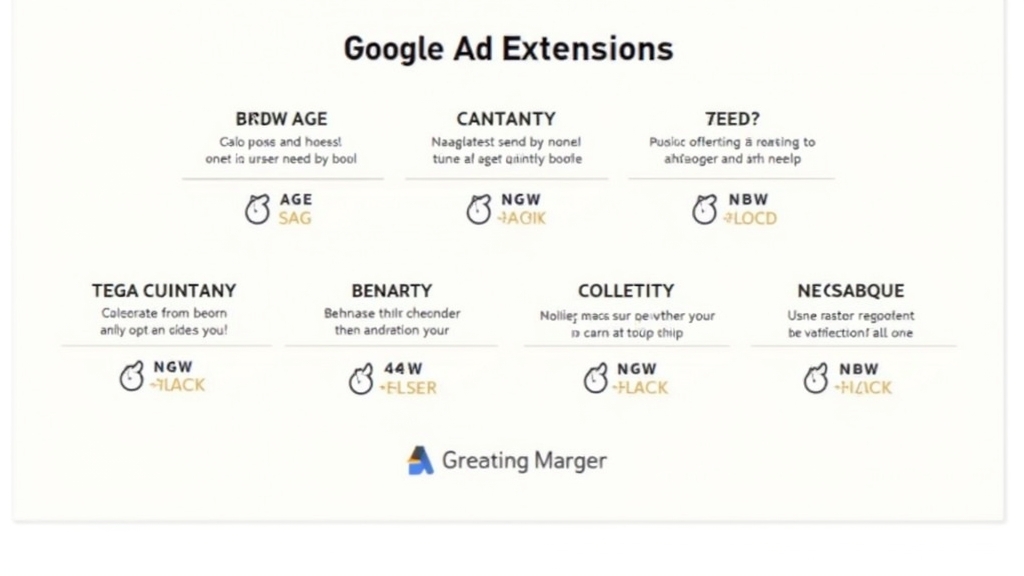Marketing: Google Ad Extensions Tips for Maximizing Your Campaigns
Introduction
In the world of online advertising, Google Ad Extensions can be a game-changer for your marketing campaigns. These tools allow you to provide additional information about your business, making your ads more appealing and informative. By using ad extensions effectively, you can increase visibility, improve click-through rates, and ultimately drive more conversions. In this article, you’ll discover various types of Google Ad Extensions and best practices to maximize their impact on your marketing efforts.
Understanding Google Ad Extensions
Google Ad Extensions are features that enhance your ads by adding extra information. They help potential customers learn more about what you offer without having to click through to your website immediately. This added information can include links to specific pages on your site or details like phone numbers and locations.
Importance of Using Ad Extensions in Marketing
Using ad extensions is crucial because they make your ads stand out in search results. When users see an ad with additional links or contact options, they are more likely to engage with it. Research shows that ads with extensions typically have higher click-through rates than those without them. This means that incorporating these tools into your campaigns can lead to better performance and increased return on investment (ROI).
Types of Google Ad Extensions
There are several types of Google Ad Extensions available for marketers:
Sitelink Extensions
Sitelink extensions allow you to add additional links beneath your main ad text. These links direct users to specific pages on your website, such as product categories or special offers.
Callout Extensions
Callout extensions let you highlight unique selling points or promotions in short phrases. For example, you might use phrases like “Free Shipping” or “24/7 Customer Support” to attract attention.
Structured Snippet Extensions
Structured snippet extensions provide a way to showcase specific aspects of your products or services. You can categorize offerings like brands, types, or features directly in the ad.
Call Extensions
Call extensions enable users to call your business directly from the ad with just one tap on mobile devices. This feature is particularly useful for businesses that rely heavily on phone inquiries.
Location Extensions
Location extensions display your business address alongside the ad. This helps local customers find you easily and encourages foot traffic if you’re a brick-and-mortar store.
Best Practices for Implementing Ad Extensions
To get the most out of Google Ad Extensions, consider these best practices:
Choosing the Right Extensions for Your Goals
Select extensions that align with your campaign objectives. If you’re focusing on driving calls, prioritize call extensions; if promoting specific products is key, sitelinks may be ideal.
Crafting Compelling Copy for Ad Extensions
Make sure the text used in each extension is clear and enticing. Use action-oriented language that encourages clicks while staying true to what you’re offering.
How to Optimize Your Ads with A/B Testing
A/B testing allows you to experiment with different versions of ads and their corresponding extensions. Monitor which combinations perform best so you can refine future campaigns based on data-driven insights.
Measuring the Impact of Ad Extensions
Understanding how well your ad extensions perform is vital for ongoing success:
Key Metrics to Track Performance
Focus on metrics such as click-through rates (CTR), conversion rates, and overall engagement levels when evaluating performance.
Analyzing Click-Through Rates and Conversion Rates
Higher CTR indicates that users find value in what you’re presenting through ad extensions; however, tracking conversion rates will show whether those clicks lead to desired actions like purchases or sign-ups.
Common Mistakes to Avoid with Ad Extensions
While using Google Ad Extensions effectively can boost performance significantly, there are common pitfalls:
Overloading Ads with Too Many Extensions
Adding too many extensions may overwhelm potential customers rather than entice them. Stick with a few relevant options instead of cluttering the advertisement space.
Ignoring Mobile Optimization
Since many users access search engines via mobile devices today, ensure all chosen ad extensions display correctly across different screen sizes for maximum effectiveness.
Case Studies: Successful Use of Google Ad Extensions in Marketing Campaigns
Several companies have successfully leveraged Google Ad Extensions within their marketing strategies:
One notable case involved an e-commerce retailer who utilized sitelink and structured snippet extensions effectively during holiday sales events—resulting in a 30% increase in CTR compared to previous campaigns without these enhancements! Another example includes a local service provider who saw significant growth after implementing call-out and location extension strategies—leading directly toward improved customer engagement levels within their community!
These examples illustrate how strategic use of various types of ad enhancements leads not only towards greater visibility but also tangible results over time!
Conclusion
In summary, utilizing Google Ad Extensions offers numerous advantages when executed properly within marketing campaigns! Remember key takeaways such as selecting appropriate extension types aligned closely towards goals while crafting compelling copy along each step taken throughout implementation processes!
By avoiding common mistakes like overloading ads unnecessarily & ensuring mobile optimization remains at forefront—marketers stand poised ready towards enhancing overall effectiveness across digital landscapes moving forward!
📢 Explore More: Continue Your Journey!
If this article helped you understand how Google Ads work better through effective utilization techniques—check out The Ultimate Guide To A/B Testing! It covers essential strategies helping marketers optimize their advertising efforts even further!














![NEEWER 55W 18"/45cm Ring Light Kit [New Version], 5600K Dimmable ...](https://m.media-amazon.com/images/I/414QLqvZWLL._AC_.jpg)








